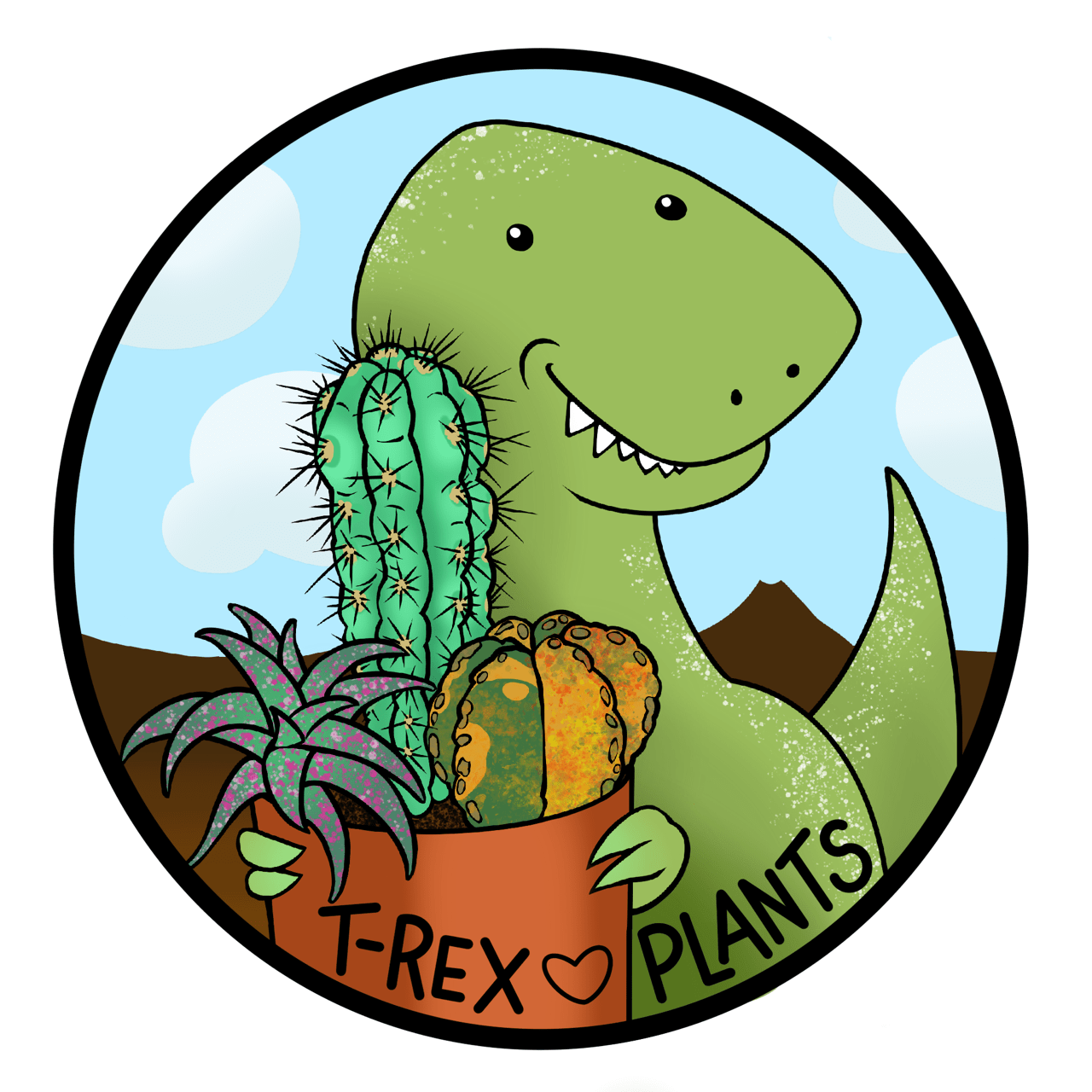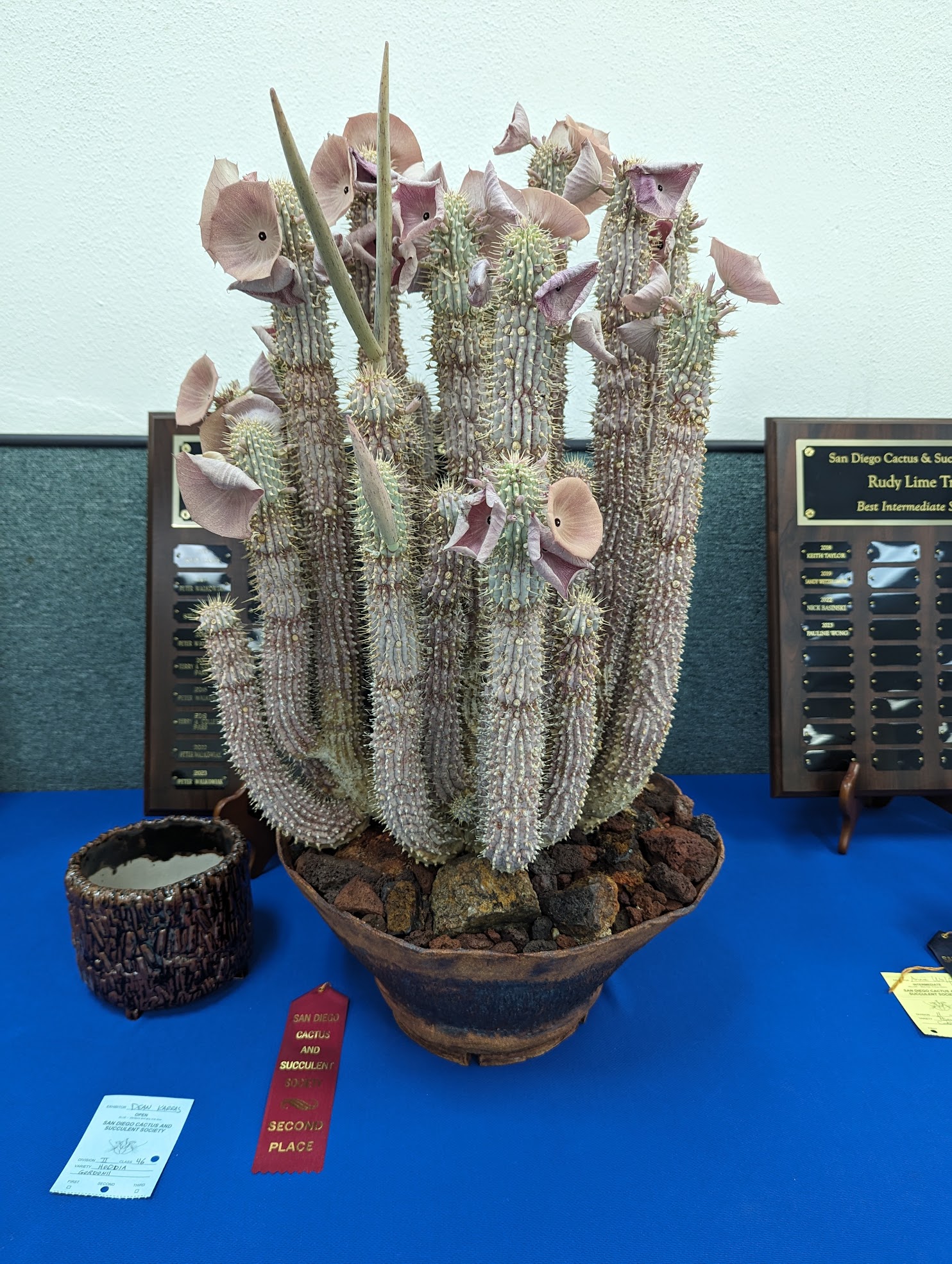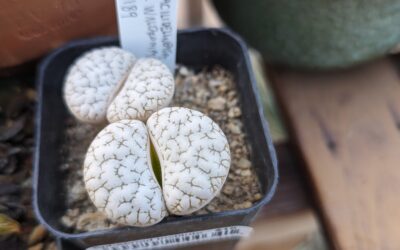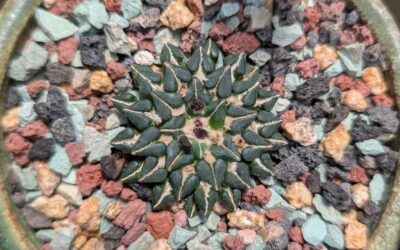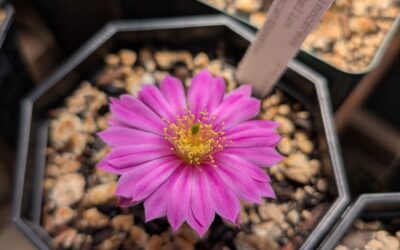This year I was fortunate enough to be both a vendor and exhibitor at the SDCSS Summer Show & Sale, and it was a ton of fun. Lots of time spent with some really incredible folks, and it’s always super cool to see the incredible specimens that other people have been growing for years. I brought over a dozen of my own plants in, and won a few ribbons – but none of the big category trophies or judge’s awards.
Before diving into the photo smorgasbord that this post (and the follow up posts) will be, a little bit of definitions for those unsure.
At our club, we have three categories: Novice, Intermediate, and Open. Novice is for new exhibitors who’ve won fewer than 10 ribbons in a show. Intermediate is for exhibitors who have won more than 10 ribbons, while Open is for the vendors to compete in as well as anyone interested in competing against them. Plants compete in categories based on species, growing patterns, or region of origin. To read more about the categories, exhibition rules, and the various details that go along with competing, I’ve linked our club’s most recent newsletter discussing the topic here.
At the end of the day, the competition is friendly and more of an opportunity to show off the plants you’re proud of than it is anything cutthroat or intimidating. If you have a local club that puts on a show, consider entering plants – especially if you’re close enough to join us at the San Diego club!
Are you or your plants featured in this post, and you would rather not be? Please email me at jen@trexplants.com and I’ll remove them.
Or…are you one of the vendors or growers, and you’d like me to link to your website? Email me and I’ll add a link!
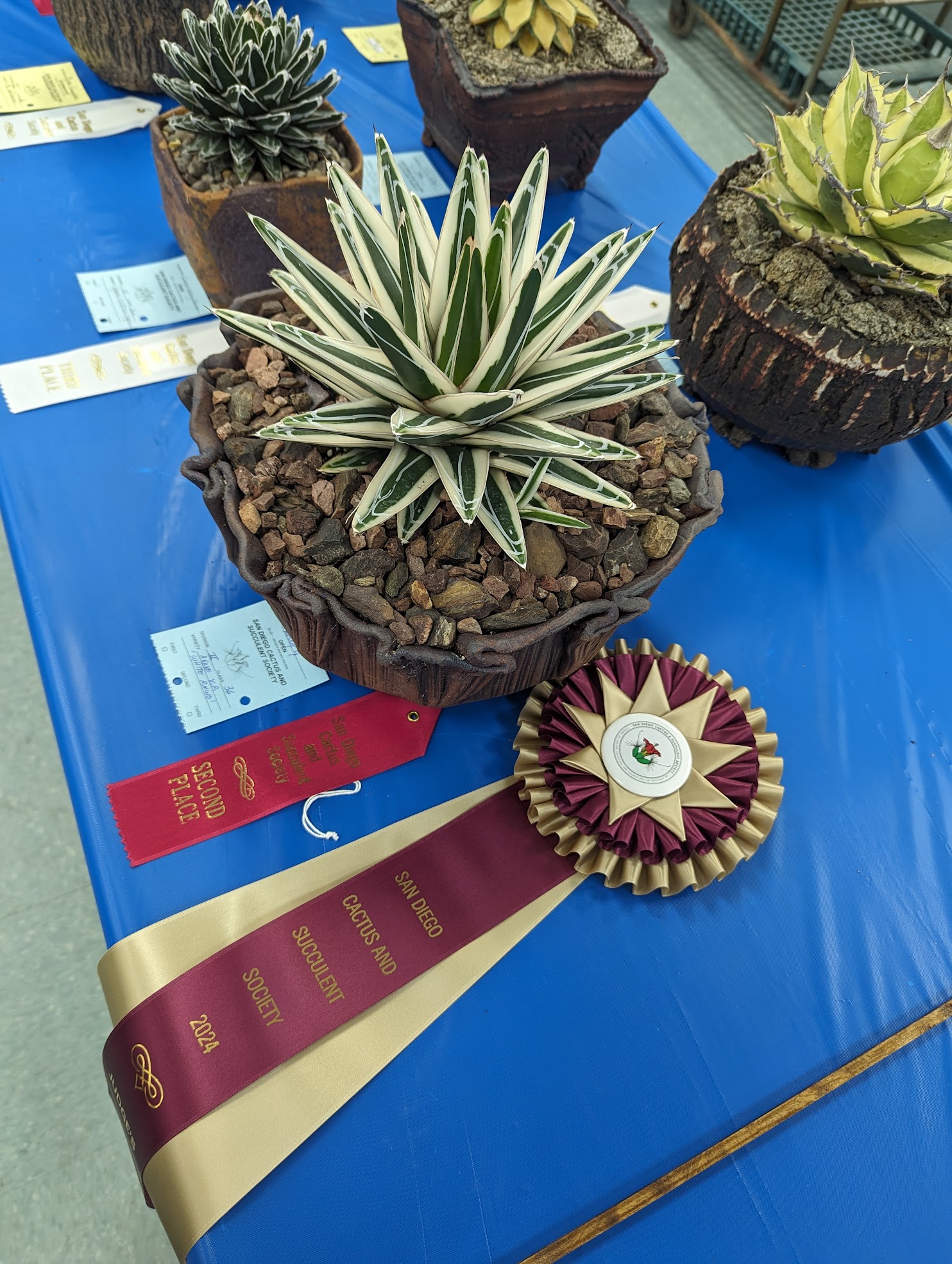
Succulent Category
I am a shamelessly selfish documentarian when it comes to this show and sale, in part because it is utterly MASSIVE!
I’ve split aloes into their own post for the sake of length and loading time.
In the meantime, we’ll start the tour of the succulents with a look at this gorgeous Agave “White Rhino”, very well grown and decently staged (if a tad over-potted for my taste).
This shows a phenomenon that happens at the show – despite taking second in the category, this plant still took home a Judge’s Award.
It’s a premium cultivar, pricey to acquire, enormously popular, and slow growing as with other Agave victoria-reginae. Part of what is impressive about this particular plant is the size: it takes years for the species to reach this size, and they are a delicate species. Impressive growing for it to be this big!
The enormously well-deserved win for the entire succulent category was the beautiful, and enormous, Hoodia gordonii that was submitted by Dean from Gnosis Nursery.
Dean’s been bringing this particular plant to shows for a while, and it is consistently one of the coolest things I’ve seen. Not only are hoodia particularly hard to grow (they are utterly unforgiving of being over-watered), but seeing one reach this size and be so beautifully potted is a genuine treat.
I think it’s neat to point out that this plant also took second in its category, but still won the best succulent plant in the show.
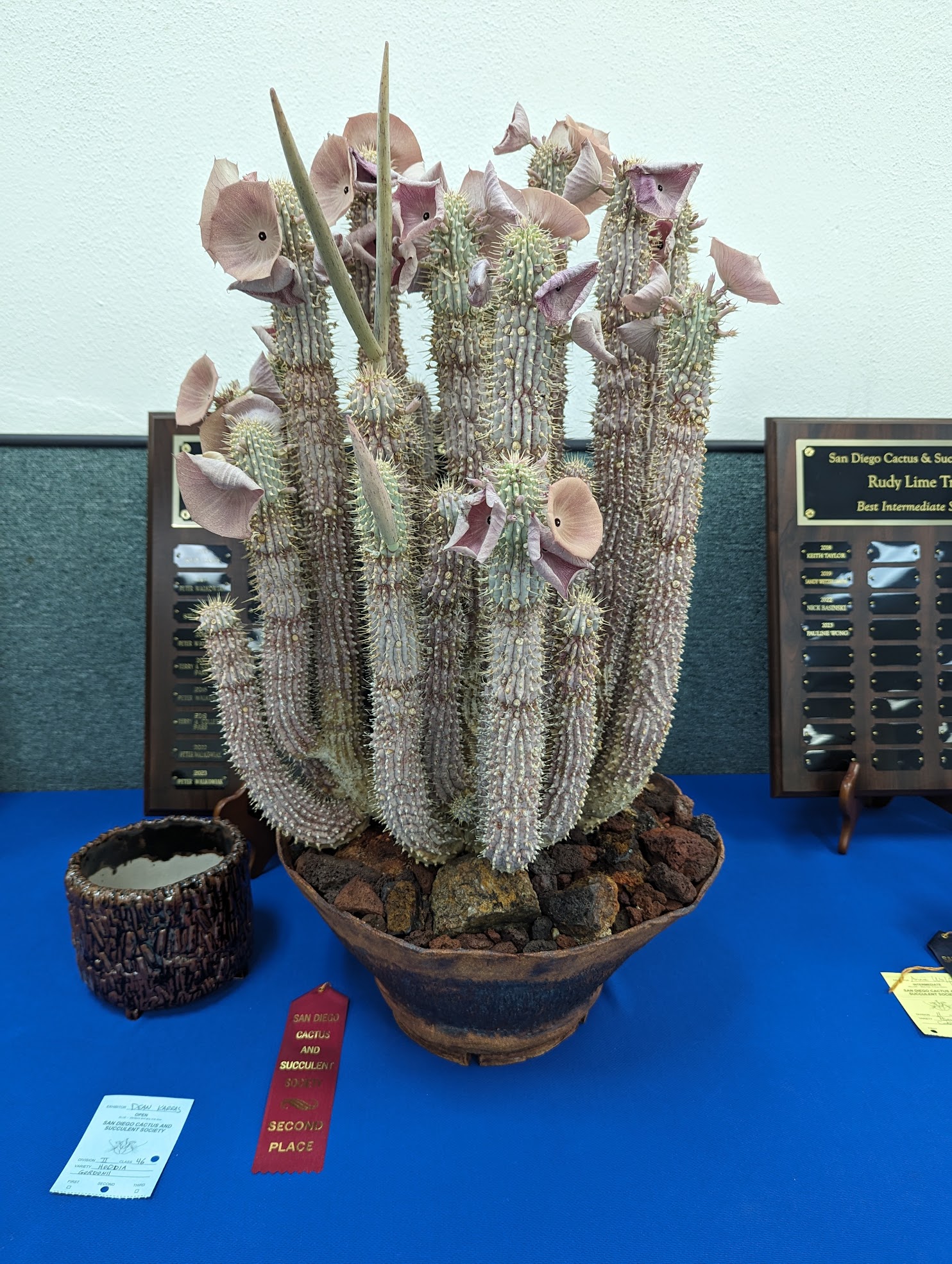
Below is a Pseudolithos cubiformis, shown by Annie Wolf in the intermediate category – and she won Best Intermediate Succulent with this plant!
Pseudolithos is another hard to grow genus, being equally sensitive to overwatering and the balance between temperature and light. Seeing this one in bloom for the show was a sight!
Luckily for everyone, the blooms must have opened earlier, and the actual stink associated with them didn’t permeate the show room (as with the hoodia above).
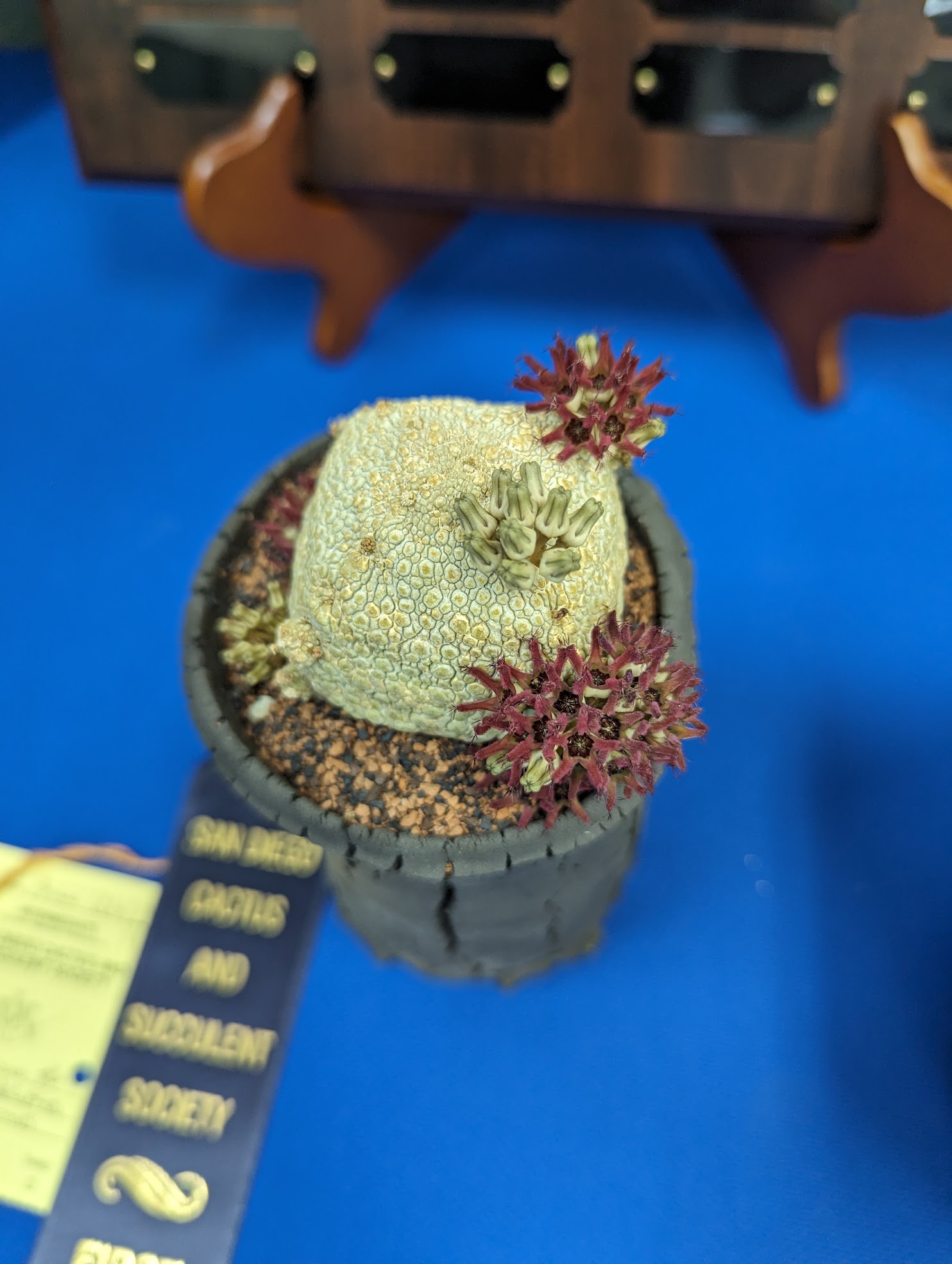
A friend has recently been trying to get me into Dorstenia, and so I spent some time checkin gout the winners over in the Dorstenia category.
This blue ribbon winner in the novice category was a gorgeous specimen grown by the wonderful Luis Gonzalez, the current librarian for the club. I’m still learning about the genus, and the species within it, but they seem almost designed to be bonsai plants.
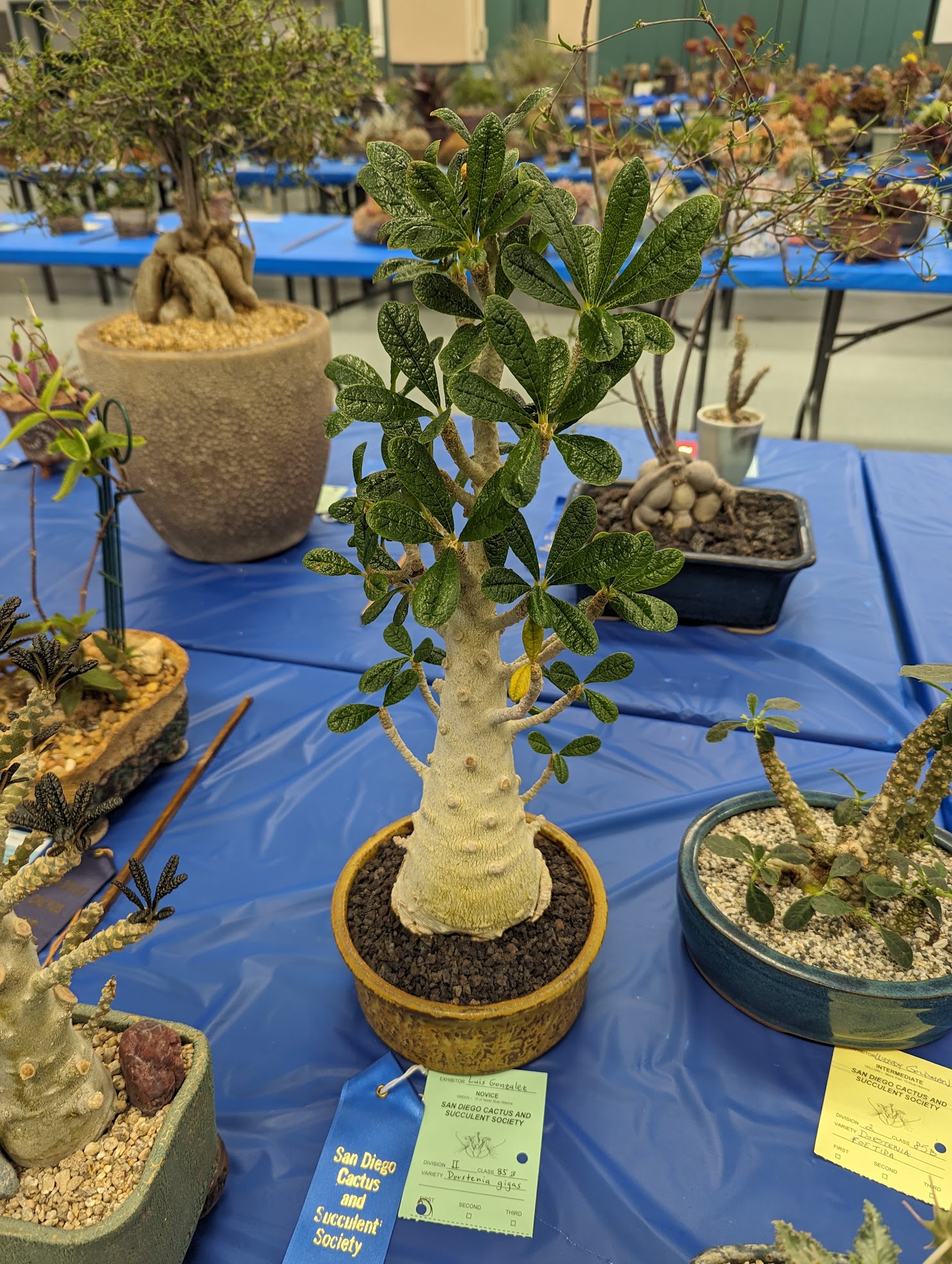
Below is a slightly different form of Dorstenia gigas, called form bullata. This one is grown by someone in the club that’s been super helpful as I learn more about the genus – Der-shing Helmer. If you’re local and able to attend meetings and you also want to learn more about them, it’s worth finding her to ask!
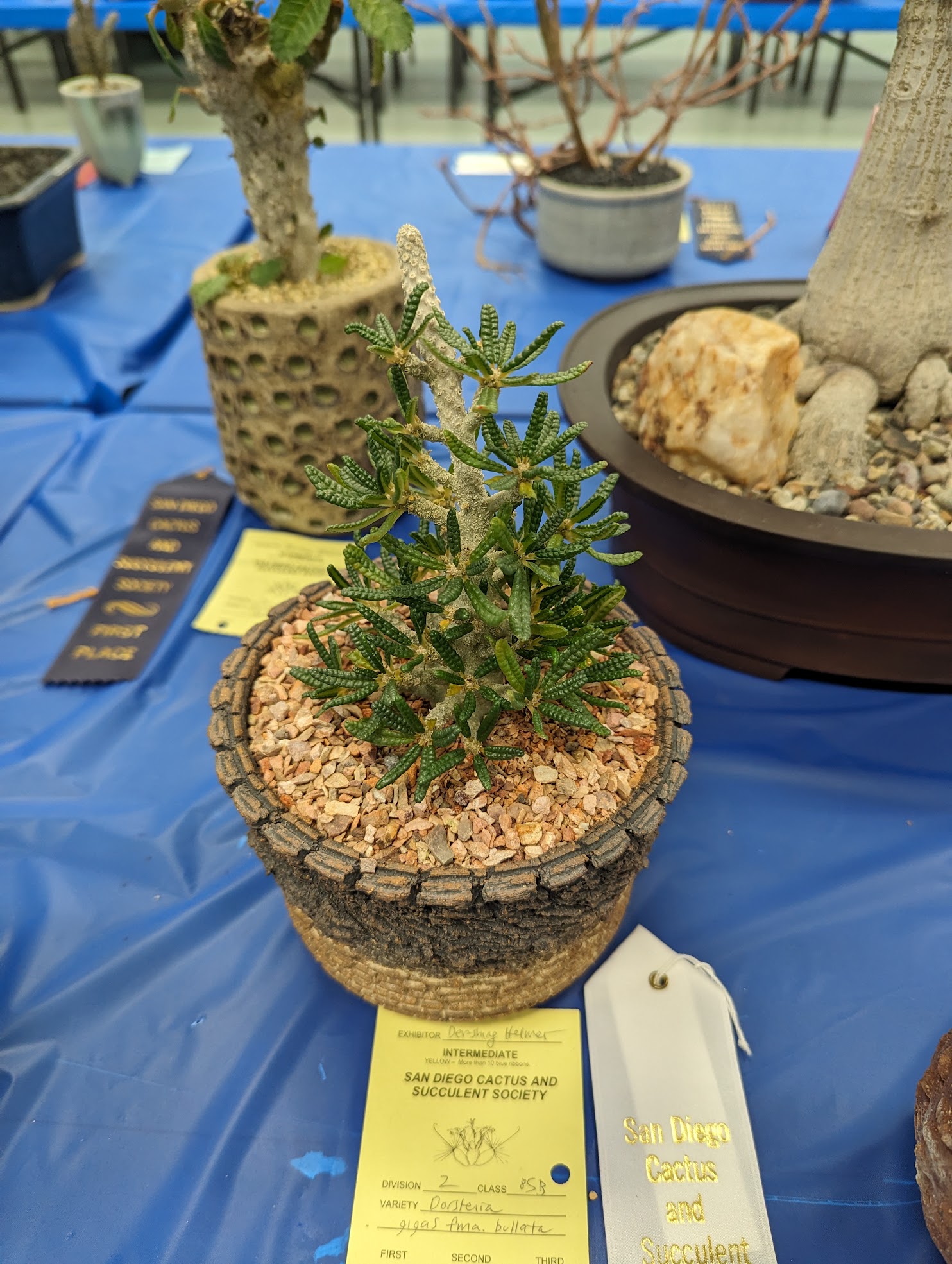
I am not the hugest fan of most soft succulents, not because I don’t enjoy them, but because they die on me all the time – at least, the fancy ones I would want to take to a show. Stuff in the ground doesn’t count in that statement, as it serves a different purpose, but those crassula are grown in large quantities and often don’t have the same attractive qualities or challenges to their cultivation that attract many of us to the rare and exotic.
There’s a very notable exception in the genus for me: Crassula susannae, a small, densely growing little succulent that looks absolutely unreal.
I’m vaguely obsessed with the species, but haven’t been able to grow it myself. I’ve had to settle for ogling the one brought in by the Sphaeroid Institute, lead by Stephen Hammer.
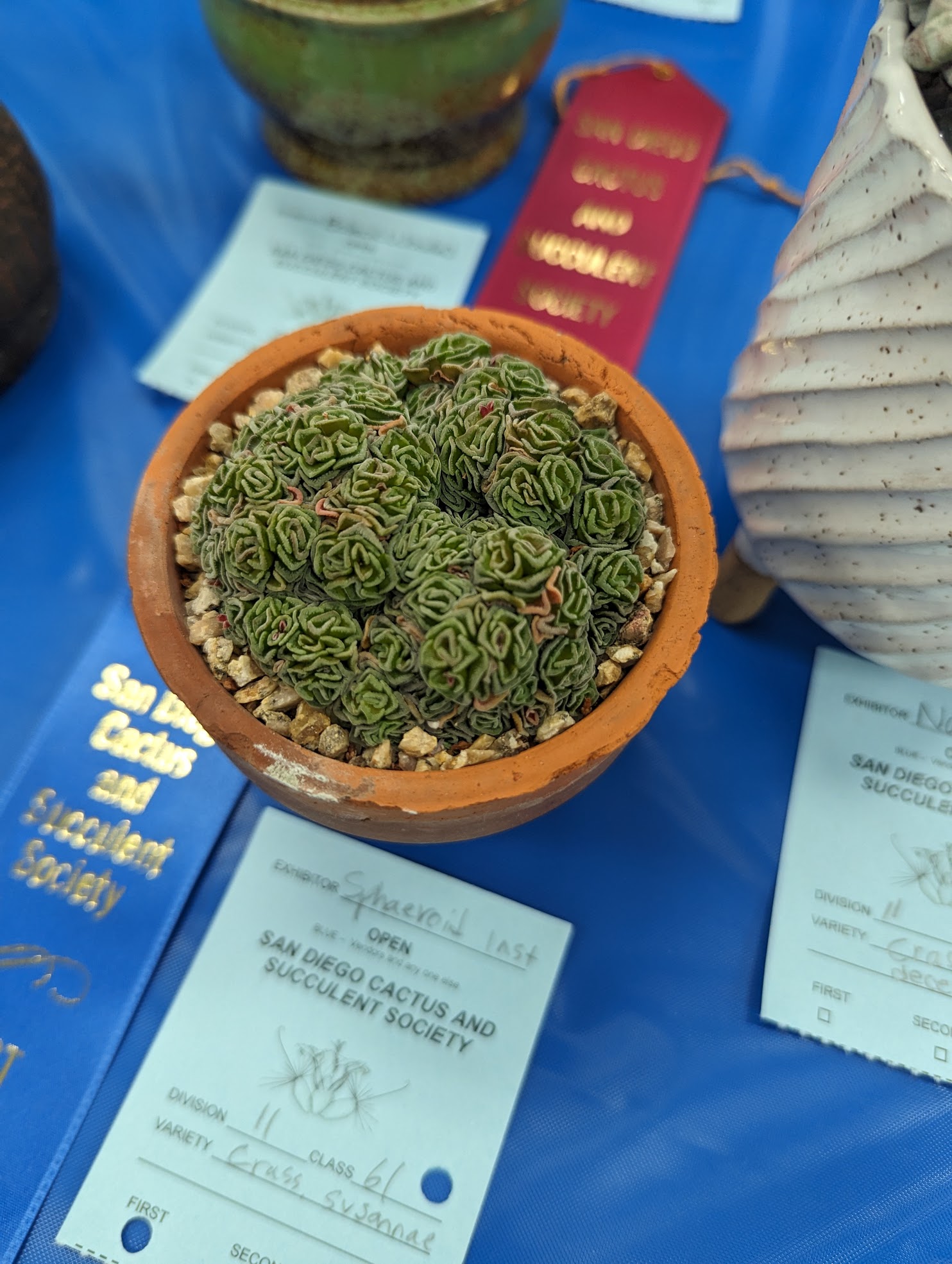
The Echeveria below was a very well staged, gorgeous looking Echeveria agavoides “Ebony” that caught my eye. This category is always competitive, and I like to browse briefly to see if there’s anything notable. I adore the Ebony cultivar, and this was a particularly attractive example.
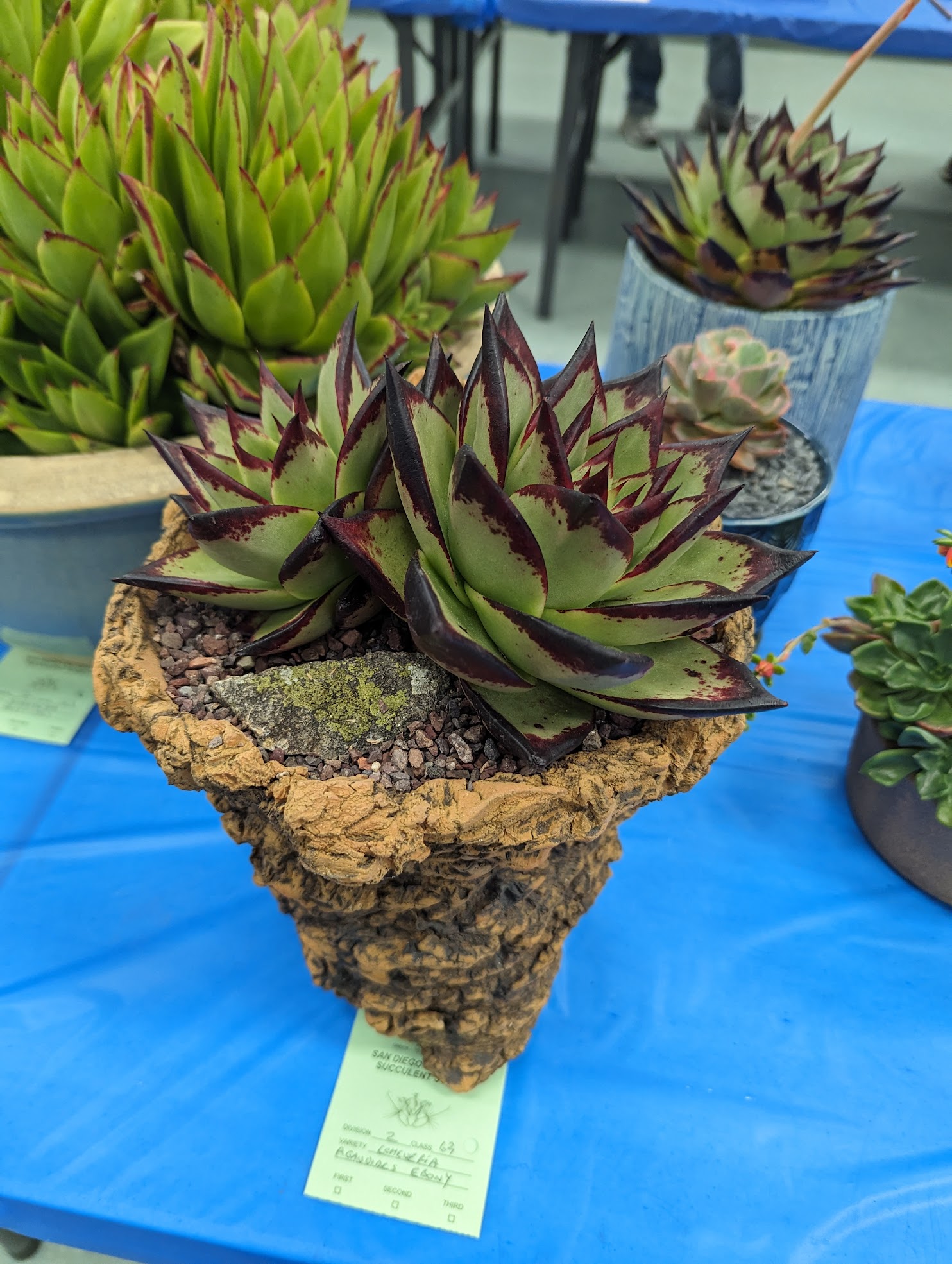
Finally, one of my own plants in the show!
A Gerrardanthus macrorhizus, or a “bigfoot plant” (I’ve also seen it called an Elephant’s Foot), is one of my first big caudiciform plants. I got this one back in 2016, from an exotic plant grower, and have been slowly nurturing it to grow to about 12″ across. I won second place in my category!
It was the first time I’d ever brought this plant in, and it was super satisfying to win a ribbon in a new category.
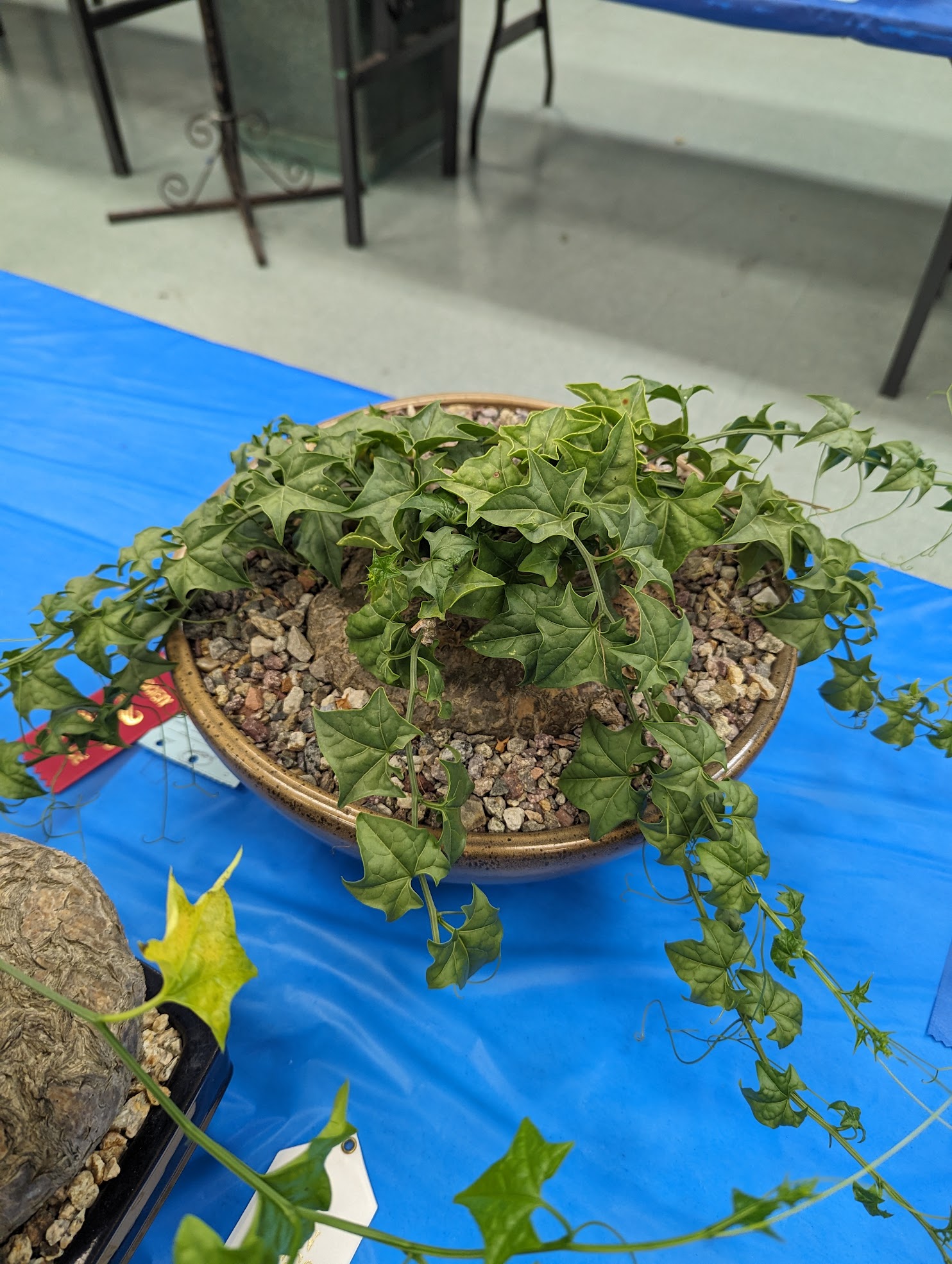
I’m not even mad I lost to this plant in the category. Look at it! There must have been some sort of pest or damage to the center of the caudex, and the Gerrardanthus survived and carried on anyway.
As you can see in the photo, it won Best Pachycaul or Caudiciform for the entire show, and was well deserved.
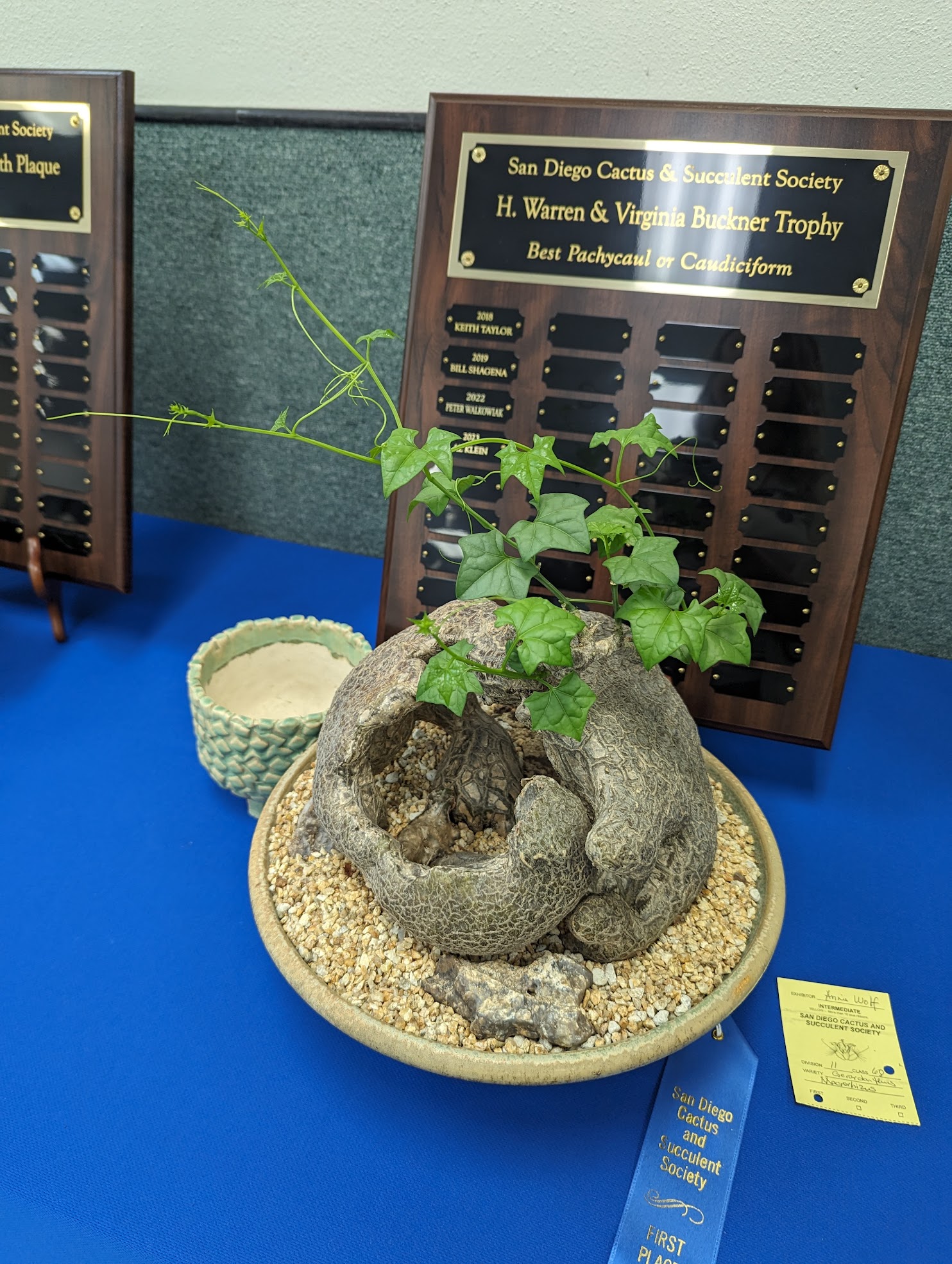
A gorgeous Euphorbia persistens shown by TGZ Ceramics, a lovely local potter who has a great eye for specimens. This was in a category I shared for the first time as well – the caudex-forming Euphorbia category.
This one also won a judge’s ribbon!
I couldn’t see a caudex in this plant, and as a new exhibitor in this area, I’ll have to pay close attention during the judging of the winter show and sale to see what the judges look for. Caudex aside, the plant itself was clearly well grown and in beautiful shape. Made me want one of my own!
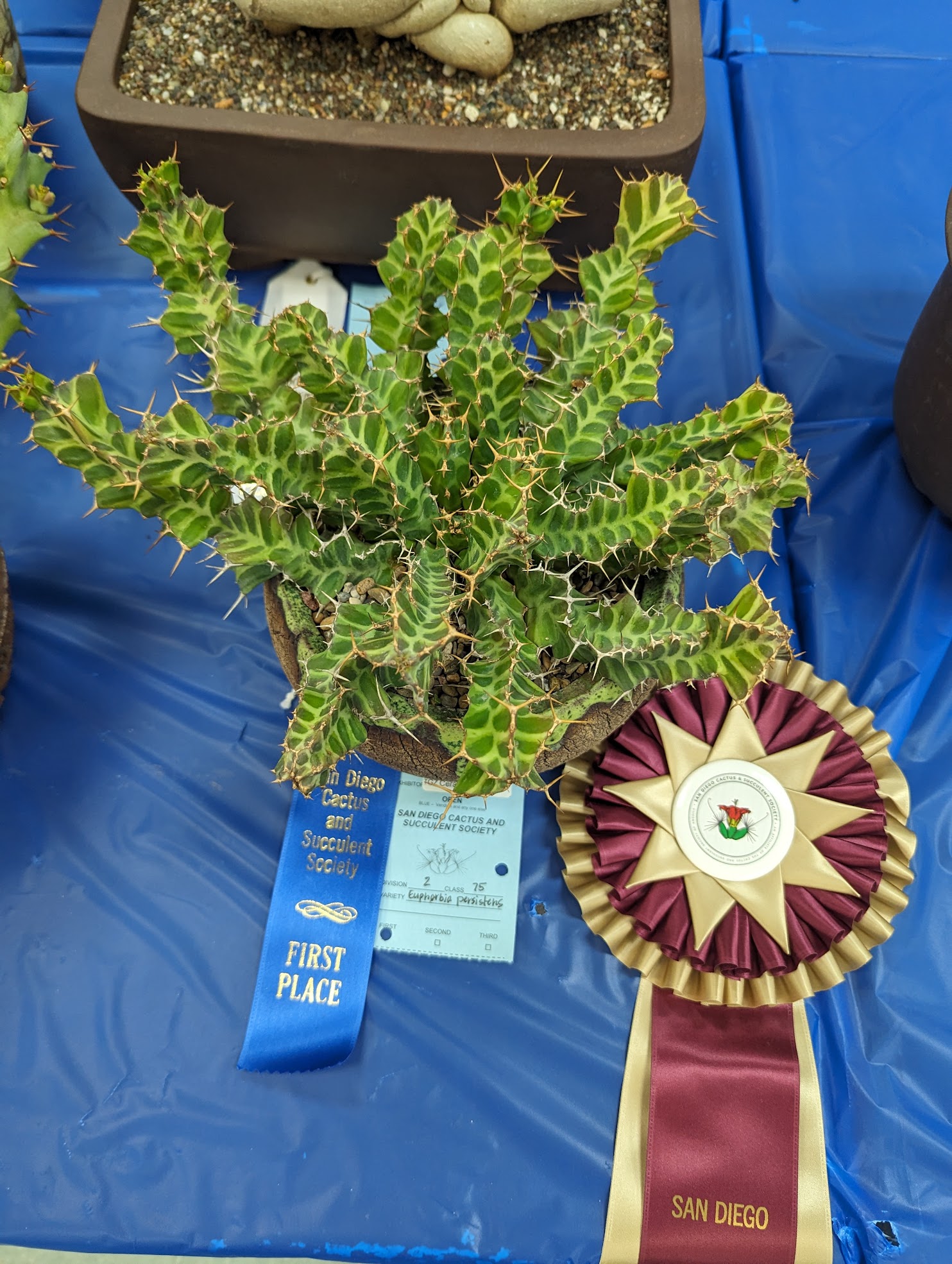
My entry into the category – a Euphorbia tortirama I’ve been growing for a couple years. I’ll admit I was surprised to take second place; there was another tortirama in the category that looked (to my eyes) as a better, more compactly grown specimen. Maybe it was my petrified wood staging?
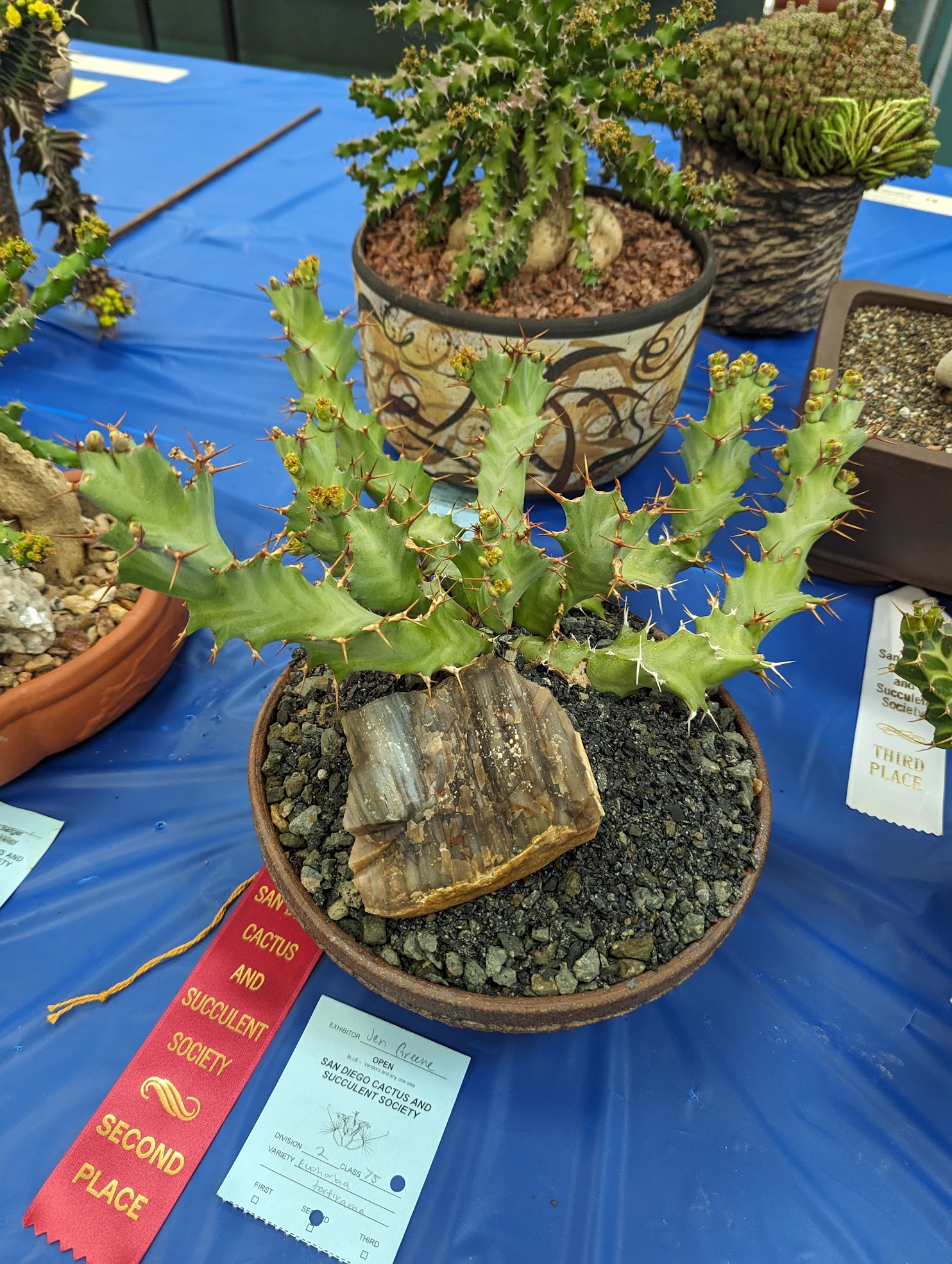
Best Euphorbia in Show went to a tidy and well grown little Euphorbia kalisana from Jared Petker, who really showcased a ton of well-grown Euphorbia this year. San Diegans are lucky to have him as a member, as he’s written articles for our newsletter and given presentations on the nuances of the Euphorbia genus at our meetings.
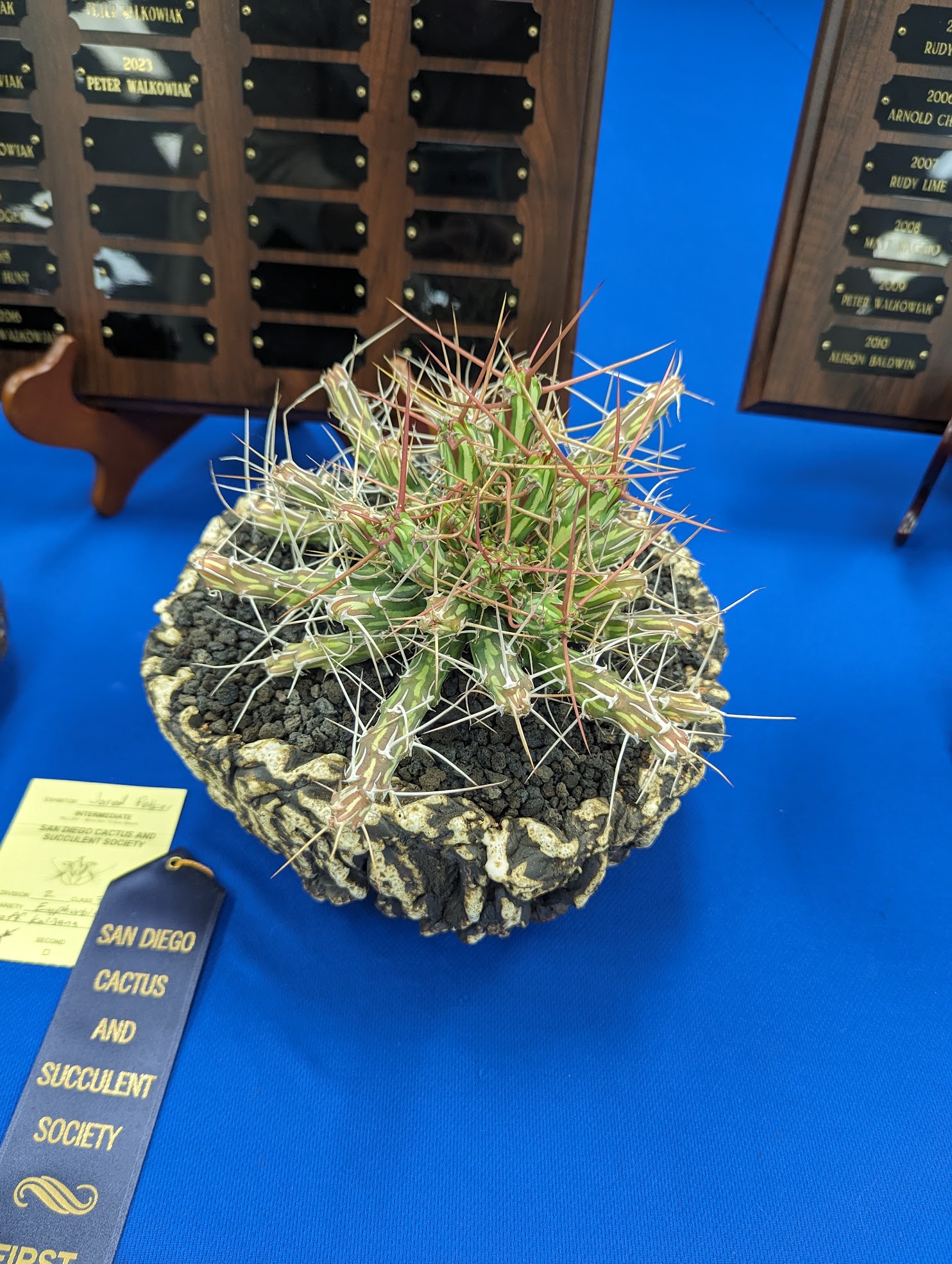
Before we leave the Euphorbia genus in the show, a moment spent to see these cute little Euphorbia turbiniformis from Thorn Oasis, a new vendor in the club. It won the notable award of being the rarest plant species in the show!
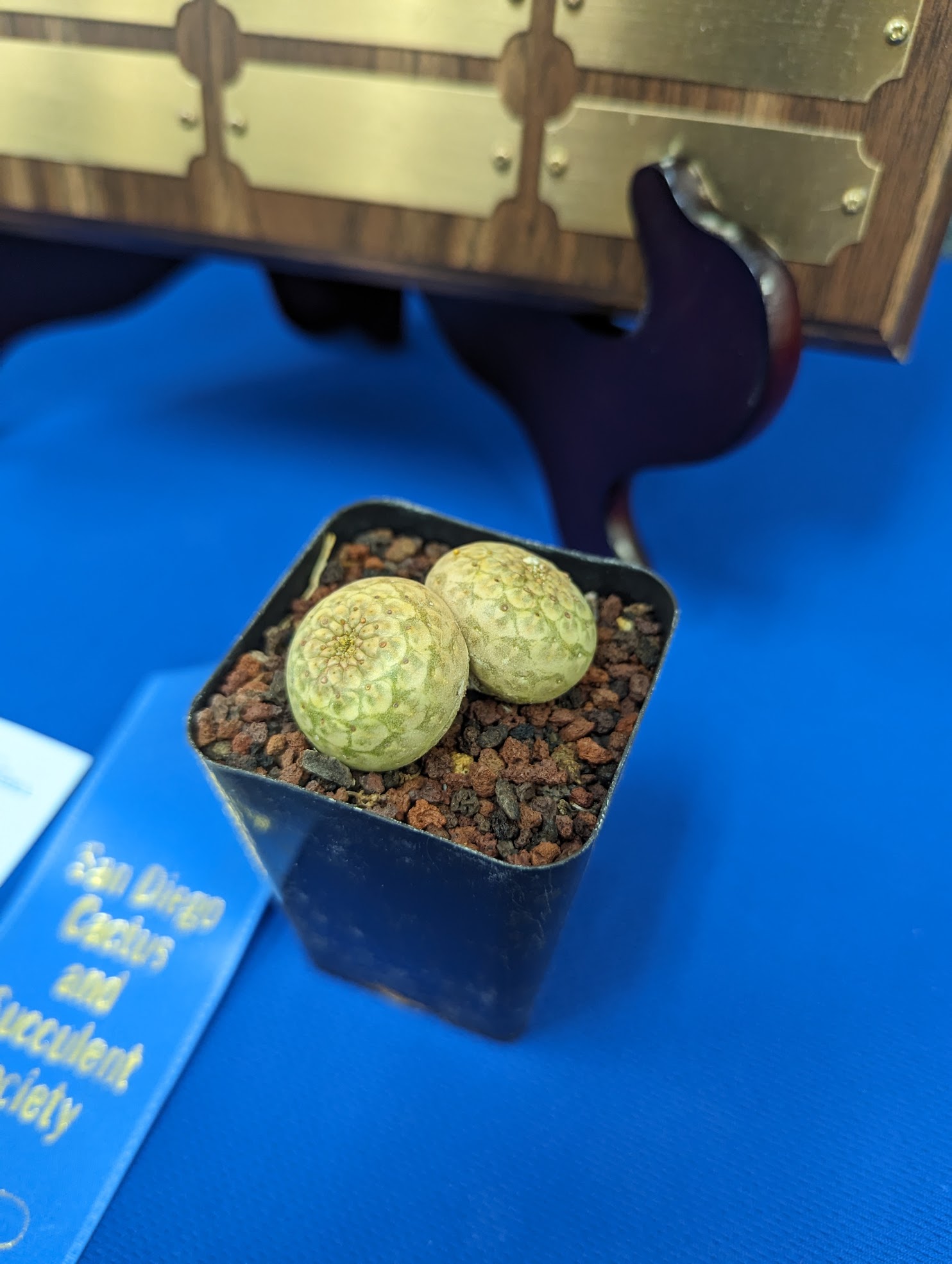
We’ll start our tour through the mesemb category with one of mine brought in to exhibit – my little Cheiridopsis pillansii, one of the first plants I imported back in 2019 and have been growing ever since.
Based on what I’ve learned in the years since I potted this plant in the show pot it’s in, I may repot it this fall to give it some time to continue to grow and expand. I have several that I planted in-ground in 2023 that have become massive, so the root space on a multi-headed plant like this one seems greatly appreciated. If I want it to keep getting bigger and winning ribbons, it needs more room to grow!
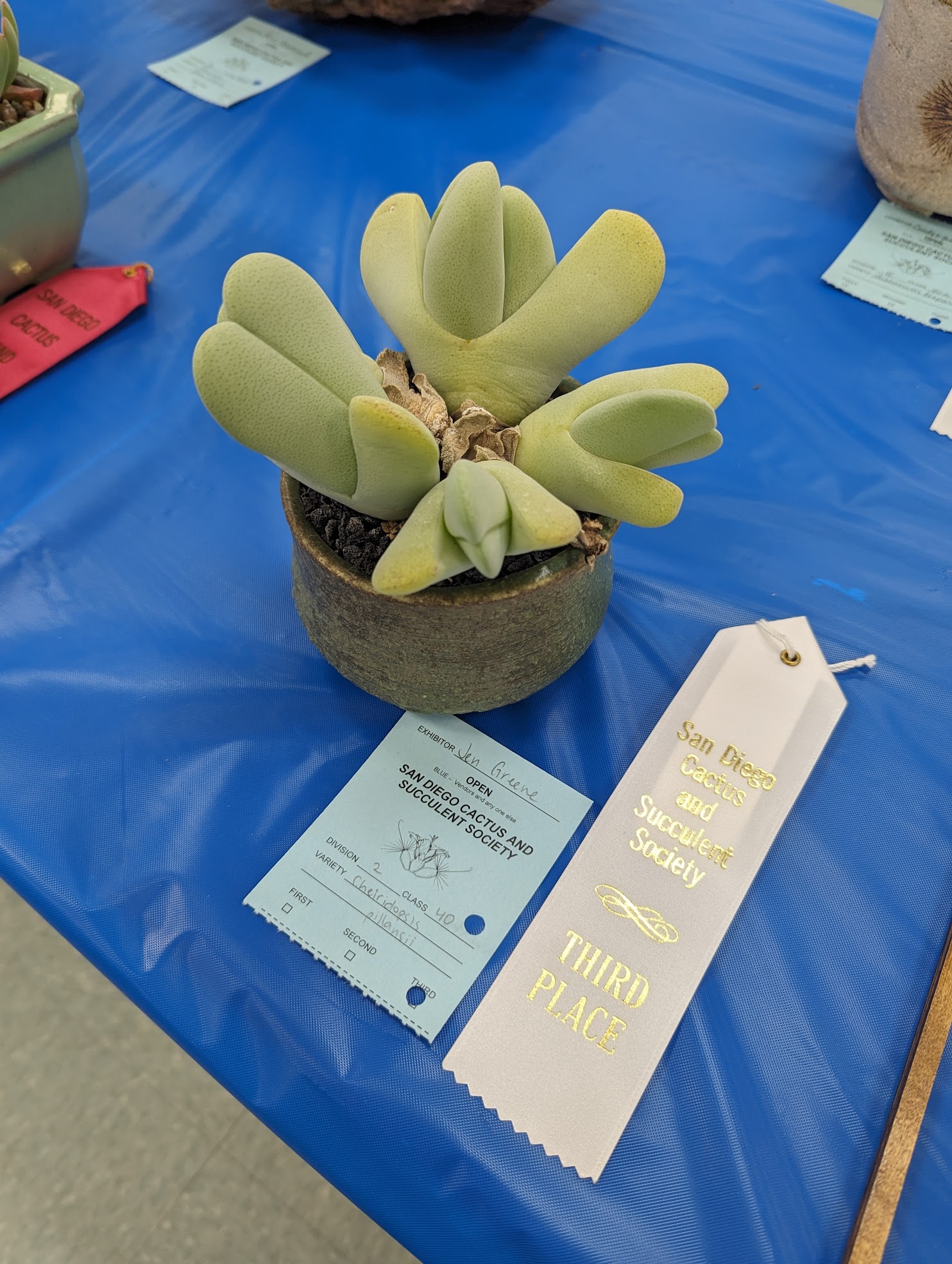
Unsurprisingly, the winner of Best Mesemb in the show went to the Sphaeroid Institute – this year, for an old and tidily grown clump of Gibbaeum heathii “small form”.
These plants are a great example of how a well grown specimen plant can win, even in a simple plastic pot. The judges here recognized the probable age of the plant (likely 10 – 20 years), as well as the skill to grow it to this size of a cluster.
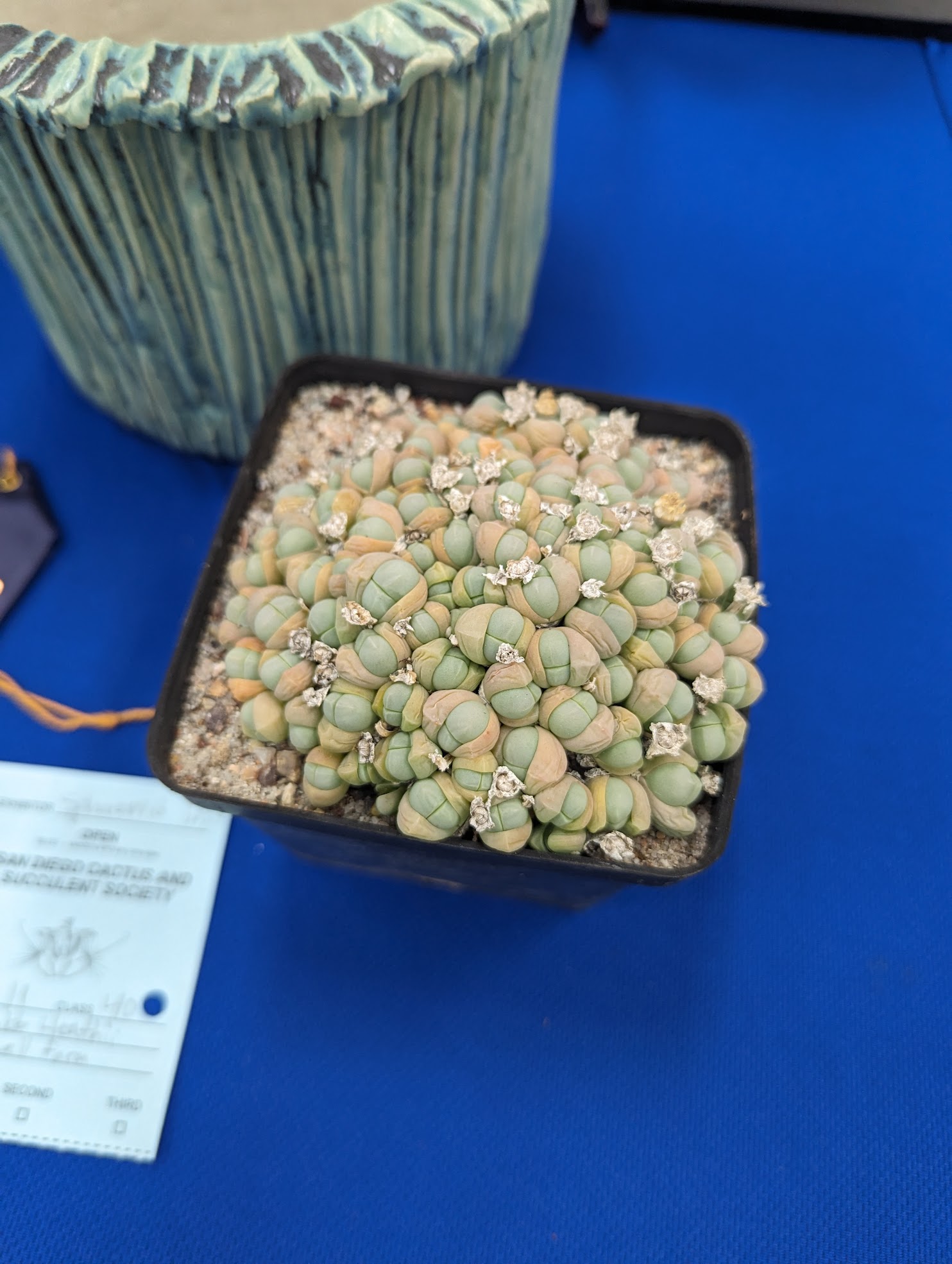
Continuing the trend of impressive plants from Steve Hammer at Sphaeroid Institute, here’s a sleeping clump of Conophytum ficiforme that took first place – even with the skins covering up the leaf bodies.
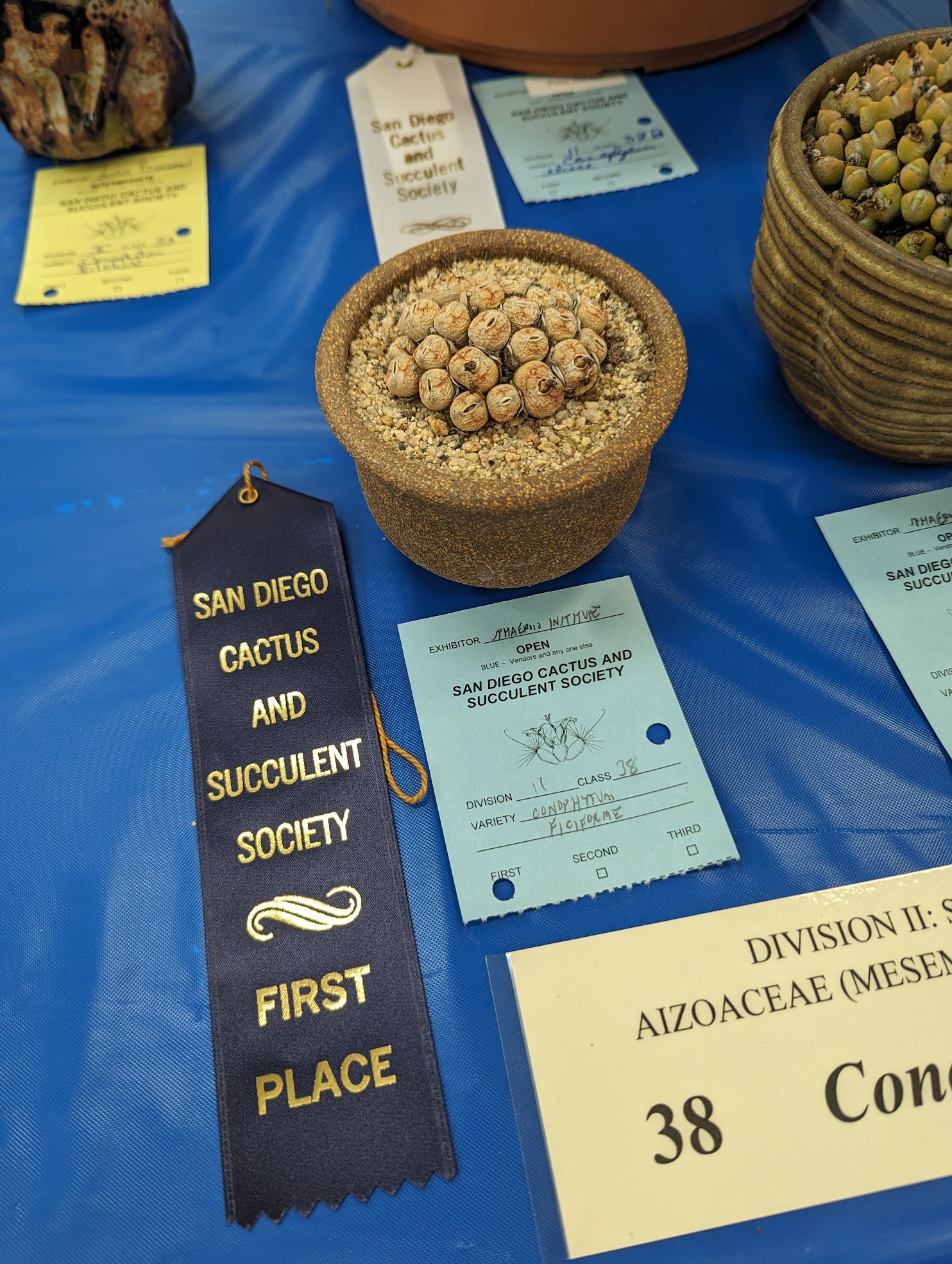
Also to no one’s surprise, second place went to another Conophytum from the Sphaeroid Institute – Conophytum quaesitum (I think that’s the correct latin name).
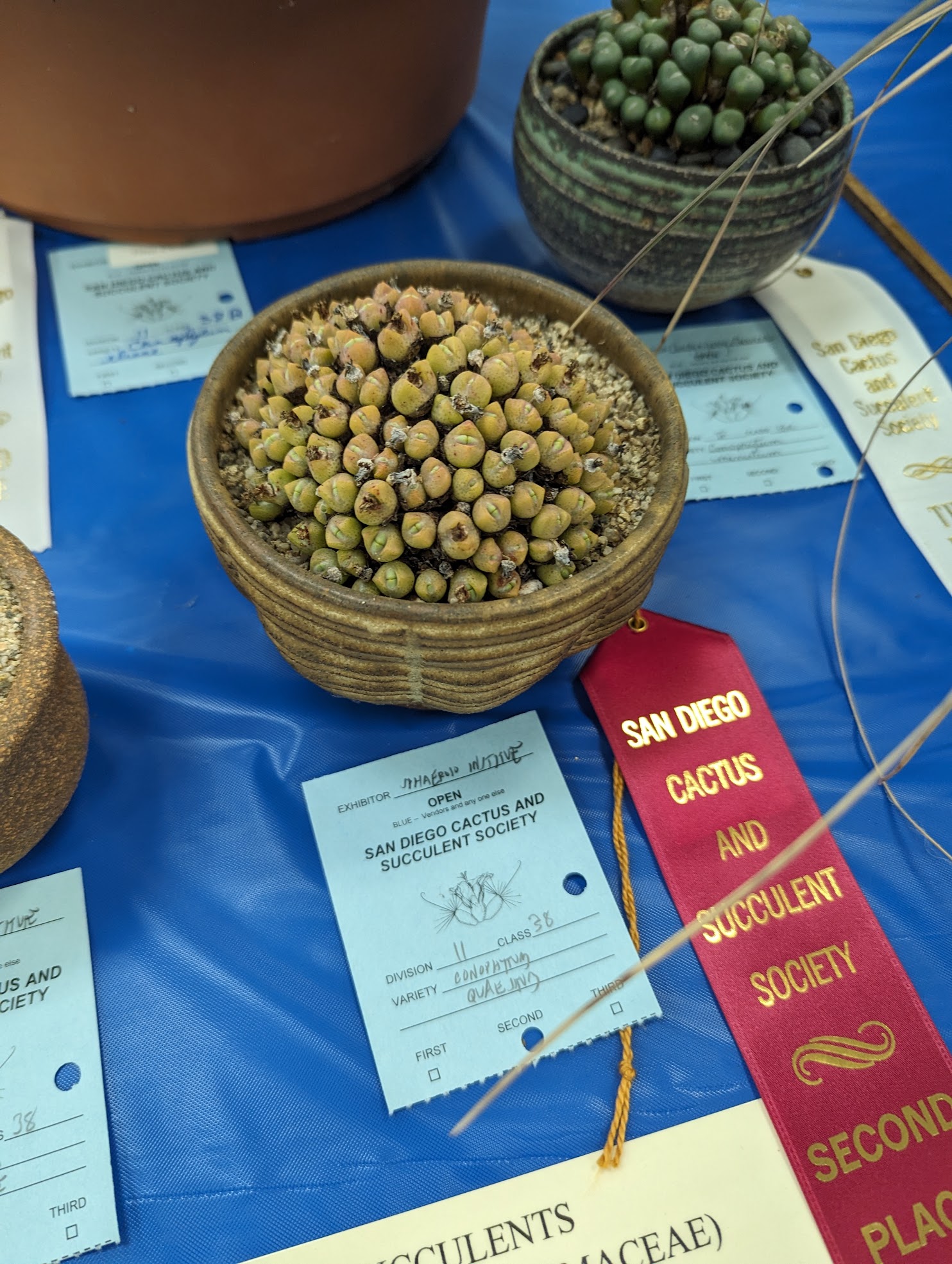
I didn’t catch the name of the exhibitor for this well grown and very old Cheiridopsis vanzylii, but the writing doesn’t look like it belongs to Sphaeroid Institute (and Steve Hammer’s very characteristic style).
This plant had beautiful coloration which I assume comes from artfully applied sun stress. Cheiridopsis spent the summer rest period with the older leaves absorbed, so this person appears to have been in the same stage of growing as I’ve seen in my own plants. Most of mine are in a similar stage of new leaves emerging but old leaves not absorbed yet, despite us rapidly approaching the official start of the summer season.
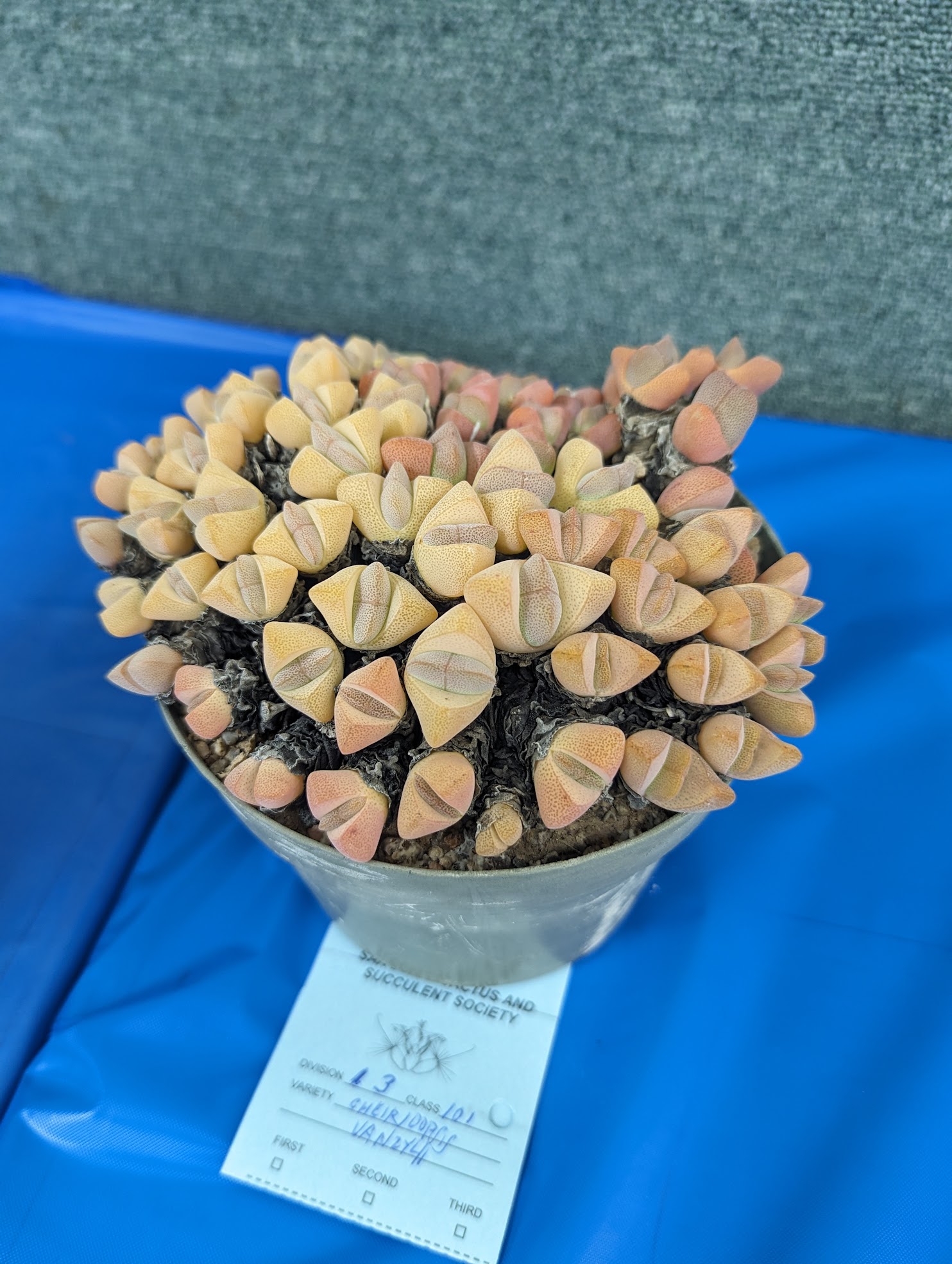
A cute little Gibbaeum dispar in a beautiful pot. I’m a fan of switching up the top dressing to better exhibit the plants, and this one used what looks like mixed small-grade landscaping pebbles. I like the variety and the smooth stones as they give you an idea of how this plant may have looked in the wild, hidden against other pebbles and stones.
You can also see a hint of reddish blushing, indicating that this specimen is receiving just enough sun to cause some blushing. The outer leaves are still being absorbed ahead of summer dormancy, although these are farther along than the Cheiridopsis exhibited.
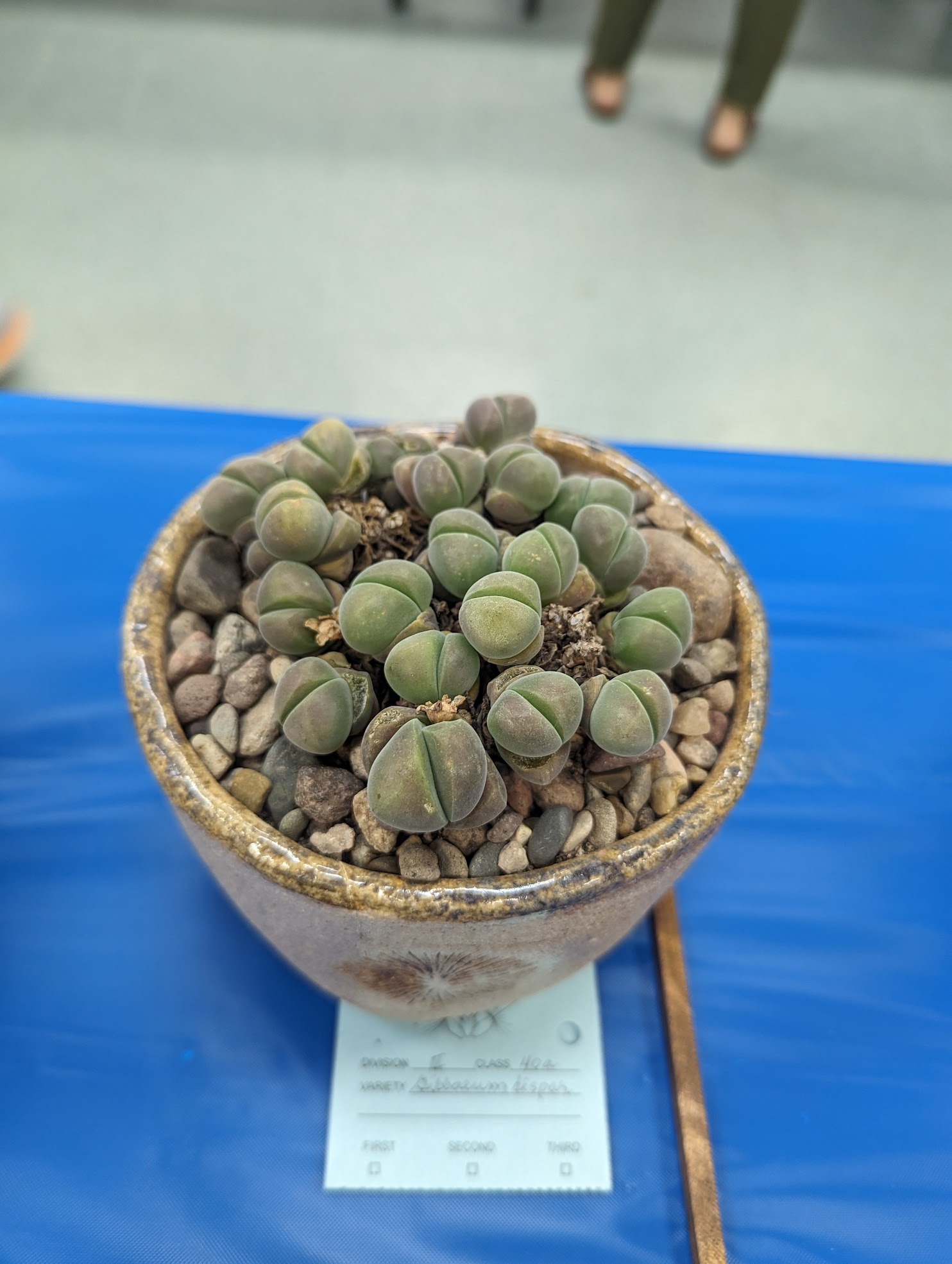
I can’t remember if this plant won any ribbons, but I was utterly enamored with it. I’ve seen a Gibbaeum pubescens at Steve Hammer’s greenhouses before, but nothing quite so funky.
I picked up a little G. pubescens from Steve’s table at the sale specifically because I saw this plant in the show. It’s got to be at least 10+ years old, likely much more than that, and it’s so gangly and ridiculous!
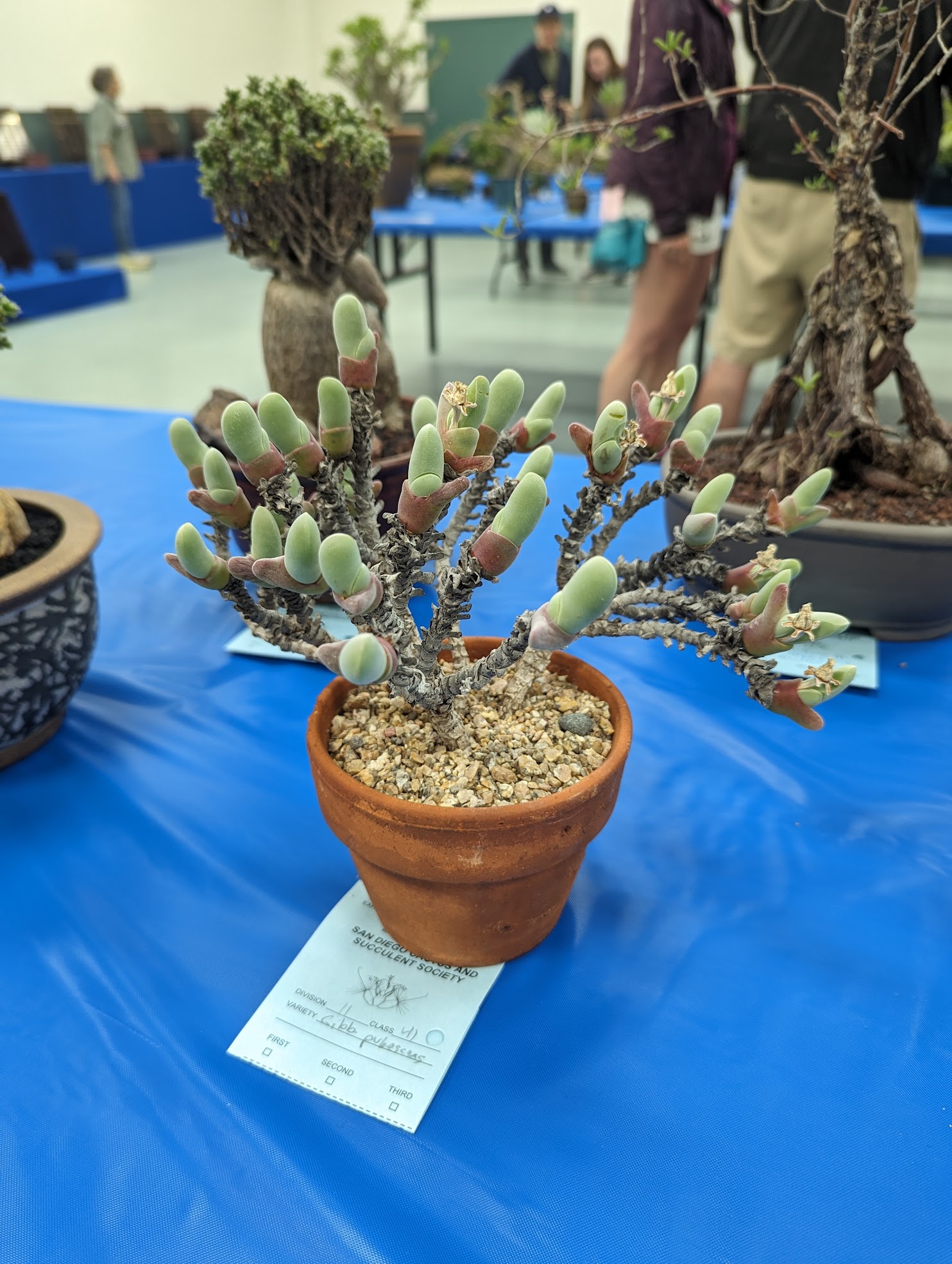
I’ll wrap the succulent section up with a couple examples of some older clumps of cultivated Lithops.
Both are well grown and decently plump, likely from their grower keeping them well kept as we head into summer dormancy. The Lithops karasmontana at left are still absorbing old leaves, so they’re surprisingly late to finish preparing for summer. The Lithops lesliei (an attractive red form) look newly potted in that show pot, and are plump and ready to start their dormancy for summer.
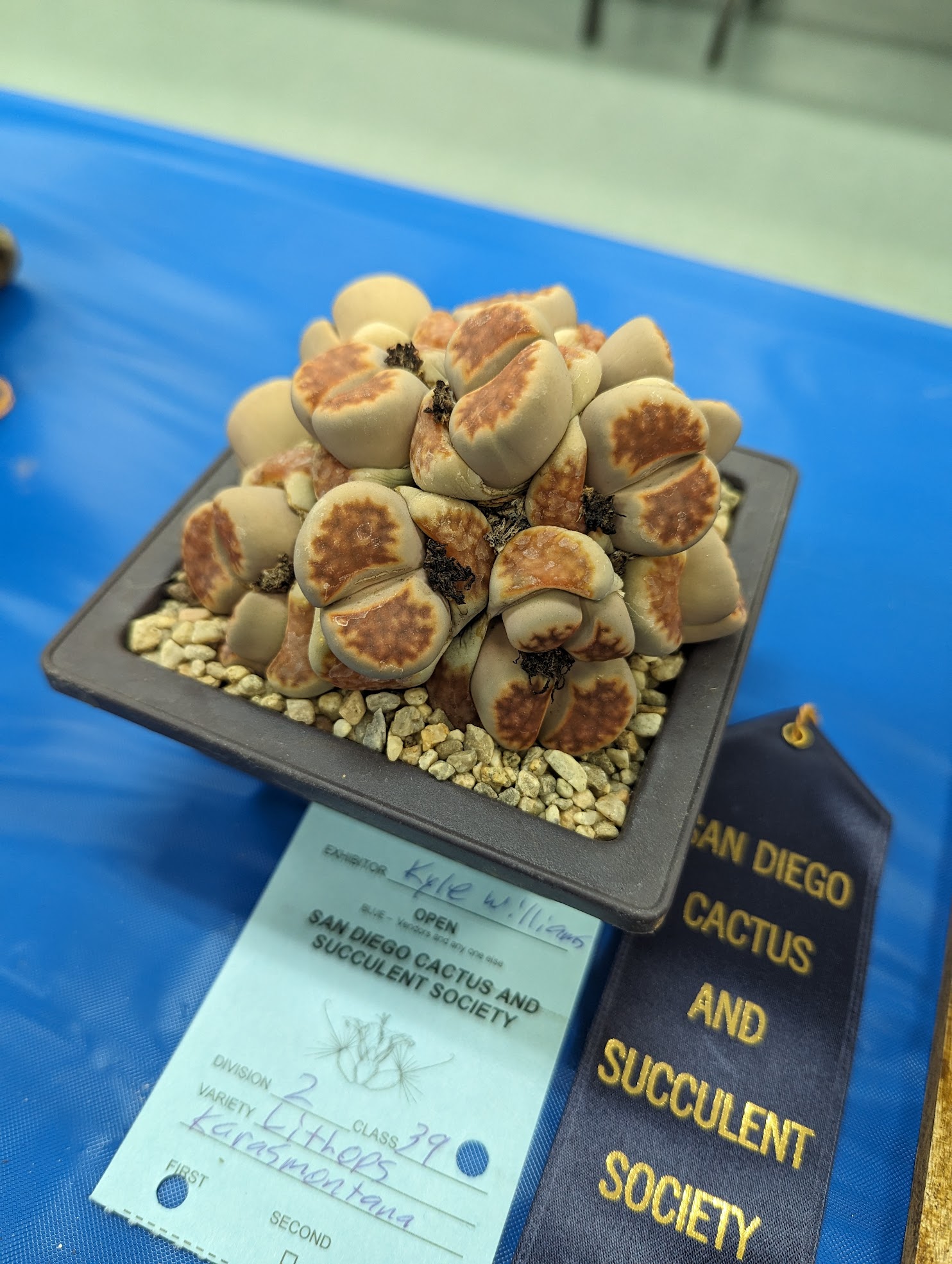
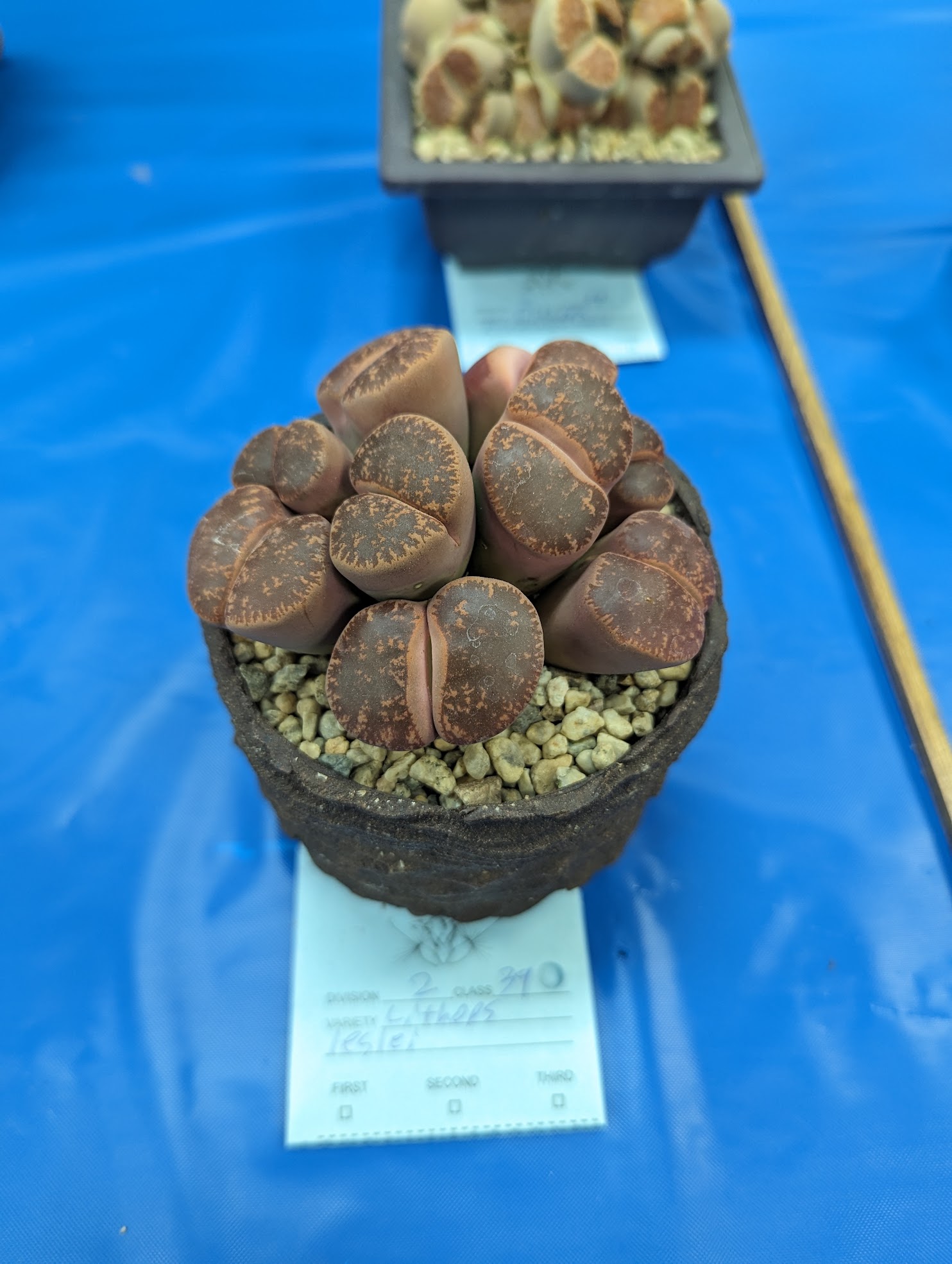
I’ll be posting more this week with the show recaps and my highlights, so keep checking back!
